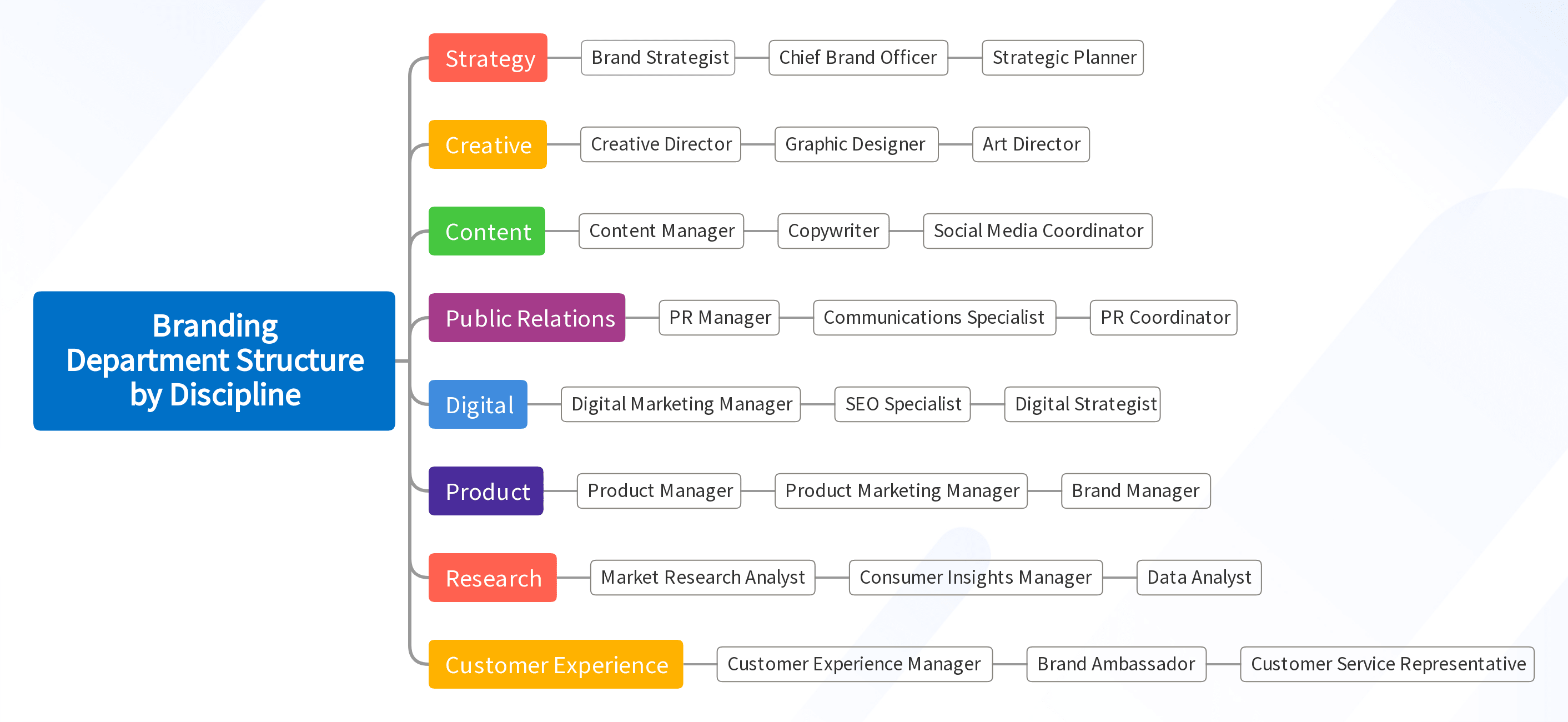

Branding teams are key players in today's fast-paced business world. They shape how a company is perceived, influencing customer choice.
Structuring such a team requires strategy and foresight. It's about assembling a group who can breathe life into a brand. I speak from experience from running my own marketing agency, GrantSpark.
But first, let's talk about the Branding department structures you have to choose from.
Best for Growth Marketers
Best for Paid Ads & CMO's
Table of Contents
Structuring Branding Department
There are two main types of department structures based on company size and resources.
- Branding department structure by discipline
- Org Type: Traditional corporate departments
- Best For: Midsize/Enterprise companies
- Branding department structure by function
- Org Type: Employees are grouped by activities and objectives
- Best For: Small to Medium Sized Business (SMB)
Let’s go in-depth to each one of them.
1. Branding Department Structure by Discipline


Discipline-based structure involves building teams centered around various marketing disciplines. For example, SEO, Content, Market Research, and Product Strategy could each form separate teams within a department.
| Discipline | Key Skills | Potential Roles |
|---|---|---|
| Strategy | Brand positioning, Market research, Competitive analysis, Understanding of consumer behavior, Creativity | Brand Strategist, Chief Brand Officer, Strategic Planner |
| Creative | Design thinking, Creativity, Attention to detail, Adobe Creative Suite, Concept development | Creative Director, Graphic Designer, Art Director |
| Content | Copywriting, SEO knowledge, Content strategy, Editing, Social media savvy | Content Manager, Copywriter, Social Media Coordinator |
| Public Relations | Media relations, Crisis management, Communication skills, Event planning, Press release writing | PR Manager, Communications Specialist, PR Coordinator |
| Digital | SEO/SEM, Data analysis, Web design, E-commerce strategy, Social media advertising | Digital Marketing Manager, SEO Specialist, Digital Strategist |
| Product | Product development, Market research, Competitive analysis, Project management, Cross-functional collaboration | Product Manager, Product Marketing Manager, Brand Manager |
| Research | Data analysis, Market research, Consumer insights, Trend forecasting, Survey design | Market Research Analyst, Consumer Insights Manager, Data Analyst |
| Customer Experience | Customer service, Empathy, Problem-solving, CRM software, Customer journey mapping | Customer Experience Manager, Brand Ambassador, Customer Service Representative |
2. Branding Department Structure by Function


Another approach is structuring by function, where teams are formed based on the different functions they perform. For example, promotion, launches, and relationship management could all be separate teams.
| Function | Key Skills | Potential Roles |
|---|---|---|
| Brand Identity | Design skills, Creativity, Brand strategy, Attention to detail, Adobe Creative Suite | Brand Designer, Identity Designer, Brand Identity Manager |
| Brand Communication | Communication skills, Copywriting, Social media expertise, Content creation, Public speaking | Brand Communication Manager, Brand Spokesperson, Communications Specialist |
| Brand Equity | Market research, Financial analysis, Strategic planning, Data interpretation, Brand valuation | Brand Equity Manager, Brand Analyst, Equity Research Analyst |
| Brand Partnerships | Networking, Negotiation, Relationship management, Strategic planning, Collaboration | Partnership Manager, Brand Partnership Specialist, Business Development Manager |
| Brand Activation | Event planning, Project management, Creativity, Problem-solving, Marketing strategy | Brand Activation Manager, Event Planner, Experiential Marketing Specialist |
| Brand Compliance | Regulatory knowledge, Attention to detail, Risk management, Communication skills, Crisis management | Brand Compliance Officer, Risk Manager, Compliance Analyst |
Branding Team Size versus Business Scale
To achieve successful marketing outcomes, you need to align the team size with your business's scale – a strategic approach that helps optimize resources and drive targeted growth.
| Business Scale | Ideal Department Size | Explanation |
|---|---|---|
| Start-up | 1-3 | Smaller teams align with budget constraints and limited needs. |
| Small-Medium Business | 4-10 | More team members support expanded operations and market reach. |
| Large Enterprise | 10+ | Large teams manage diverse branding requirements of vast operations. |
Factors to Consider When Deciding On a Branding Department Structure
- Company Size: The size of your company plays a major role in structuring your branding team. Smaller companies might need only a few people while larger companies will require a more diverse and larger team.
- Objectives and Goals: Your company's branding objectives and goals should guide the structure of your branding team. These goals could include brand awareness, brand loyalty, or market penetration.
- Budget: The resources allocated for branding activities will significantly impact your team structure. A larger budget can accommodate more team members and vice versa.
- Current Branding Status: The existing brand status of your company, whether it's already established or just starting up, can influence the structure of your branding team. Established brands may need a team to maintain and enhance their image, while startups may require a more creative and flexible team.
- Industry Dynamics: The nature and trends of your industry can shape your branding team. Fast-paced industries might need a more agile team while stable industries may afford a more traditional team structure.
Explore other marketing departments:
- Digital Marketing Team Structure
- Account-Based Marketing Team Structure
- Marketing Agency Team Structure
So, there you have it, a detailed overview of a Branding team structure. From the essence of the team and key roles, to structuring and optimizing; every aspect tailored to achieve success on your business blueprint.


















